Cross talk among calcium, hydrogen peroxide, and nitric oxide and activation of gene expression involving calmodulins and calcium-dependent protein kinases in Ulva compressa exposed to copper excess
- PMID: 22234999
- PMCID: PMC3291273
- DOI: 10.1104/pp.111.191759
Cross talk among calcium, hydrogen peroxide, and nitric oxide and activation of gene expression involving calmodulins and calcium-dependent protein kinases in Ulva compressa exposed to copper excess
Abstract
To analyze the copper-induced cross talk among calcium, nitric oxide (NO), and hydrogen peroxide (H(2)O(2)) and the calcium-dependent activation of gene expression, the marine alga Ulva compressa was treated with the inhibitors of calcium channels, ned-19, ryanodine, and xestospongin C, of chloroplasts and mitochondrial electron transport chains, 3-(3,4-dichlorophenyl)-1,1-dimethylurea and antimycin A, of pyruvate dehydrogenase, moniliformin, of calmodulins, N-(6-aminohexyl)-5-chloro-1-naphtalene sulfonamide, and of calcium-dependent protein kinases, staurosporine, as well as with the scavengers of NO, 2-(4-carboxyphenyl)-4,4,5,5-tetramethylimidazoline-1-oxyl-3-oxide, and of H(2)O(2), ascorbate, and exposed to a sublethal concentration of copper (10 μm) for 24 h. The level of NO increased at 2 and 12 h. The first peak was inhibited by ned-19 and 3-(2,3-dichlorophenyl)-1,1-dimethylurea and the second peak by ned-19 and antimycin A, indicating that NO synthesis is dependent on calcium release and occurs in organelles. The level of H(2)O(2) increased at 2, 3, and 12 h and was inhibited by ned-19, ryanodine, xestospongin C, and moniliformin, indicating that H(2)O(2) accumulation is dependent on calcium release and Krebs cycle activity. In addition, pyruvate dehydrogenase, 2-oxoxglutarate dehydrogenase, and isocitrate dehydrogenase activities of the Krebs cycle increased at 2, 3, 12, and/or 14 h, and these increases were inhibited in vitro by EGTA, a calcium chelating agent. Calcium release at 2, 3, and 12 h was inhibited by 2-(4-carboxyphenyl)-4,4,5,5-tetramethylimidazoline-1-oxyl-3-oxide and ascorbate, indicating activation by NO and H(2)O(2). In addition, the level of antioxidant protein gene transcripts decreased with N-(6-aminohexyl)-5-chloro-1-naphtalene sulfonamide and staurosporine. Thus, there is a copper-induced cross talk among calcium, H(2)O(2), and NO and a calcium-dependent activation of gene expression involving calmodulins and calcium-dependent protein kinases.
Figures







References
-
- Barr R, Troxel KS, Crane FL. (1982) Calmodulin antagonists inhibit electron transport in photosystem II of spinach chloroplasts. Biochem Biophys Res Commun 104: 1182–1188 - PubMed
-
- Beauchamp C, Fridovich I. (1971) Superoxide dismutase: improved assays and an assay applicable to acrylamide gels. Anal Biochem 44: 276–287 - PubMed
-
- Brookes PS, Yoon Y, Robotham JL, Anders MW, Sheu SS. (2004) Calcium, ATP, and ROS: a mitochondrial love-hate triangle. Am J Physiol Cell Physiol 287: C817–C833 - PubMed
Publication types
MeSH terms
Substances
LinkOut - more resources
Full Text Sources

